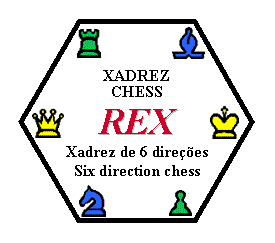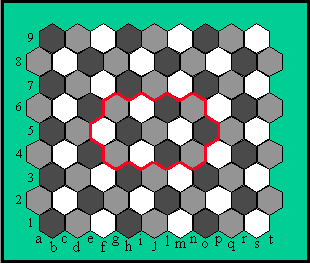
http://www.oocities.org/xadrezrex
Written by Arnaldo Rodrigues D'Almeida
Published in: April / 2002
Revised in: June/2002

5- Strategies
The strategies of REX are still not very well-known. At first, the strategies used in the traditional chess should be adapted for this game.
The player should adopt the following strategies:
1- Domain of the center;
2- Control of the space;
3- Development of the pieces;
4- King in safety;
5- Structure of Pawns;
6- Mobility of the pieces.
1- Domain of the center
The center of REX board can be considered as: j5 (the central hexagon), i6, l6, h5, m5, i4, l4 (around j5), g6, n6, f5, o5, g4 and n4 (located near to the central hexagon) (Figure 1).
Figure 1: The center of the board.

The pieces located on the center have larger attack power (mobility). The attack pieces (Queen, Rook, Bishop and Knight) when located on the center of the board (Figure 1) have the largest attack power. The Queen on the central hexagon (j5) can be moved to (attack) 40 hexagons on a empty board, and on the other hexagons of the center, the Queen can be moved to 38 or 39 hexagons. The Rook, on the center of the empty board, is capable to attack 24 or 25 hexagons. The Bishop, on the center of the empty board, is capable to attack 13, 14 or 16 hexagons (only in j5). The Knight, when located on any hexagon center of the board, empty or not, attacks 12 hexagons.
The domain of the center will force the opponent to move its pieces for the lateral ones. It will dispend extra movements to the opponent as well as it will delay the development of its pieces.
The player that has the domain of the center can move its pieces from one side to another more easily, what will allow to attack or to defend with efficiency.
The domain of the center is only important when there are attack pieces in the board. Once the Pawns have the same mobility and attack power practically in any part of the board, the domain of the center doesn't constitute advantage. When the players have only Pawns and the King, the player who has the first coronation possibility takes the advantage.
2- Space control
The space of the board is constituted of hexagons. The more hexagons of the board you attack more space it will be under its control or domain.
When one of the pieces of a player occupies an hexagon under attack by other player it can be captured. In this situation, you can say that the hexagon is under domain. Of course there are situations that the opponent will be able to capture the piece that captured his piece and to take an advantageous change. In this case it is said that the domain was apparent or there wasn't effective control.
The more hexagons are under its control, comparatively to its opponent, more mobility will have its pieces and more attack chances.
The space under control can be measured counting the number of hexagons of the board under attack. To express in percentile terms, it is need to divide by total number of hexagons, 85 (in the case of the traditional chess, 64) and to multiply by 100.

3- Development of the pieces
All the attack pieces moves to attack the center, just moving at once. One of them should only move a second time when all the attack pieces have already been moved.
When moving a piece twice consecutively, for example, it will allow the opponent to attack more hexagons, allowing the domain of the center of the board.
4- King in safety
To maintain the King in safety is important to avoid the checkmate. On the contrary it can affect others strategies.
When the King is exposed, it allows the opponent to develop its pieces, impeding you to make the same because you have to defend your King. Sometimes when you defend your King you need to move back your pieces, allowing the domain of the center by the opponent, and many times, to avoid the checkmate you lose some pieces, continuing the game in material disadvantage.
In REX, the King has a smaller mobility, and the other pieces, except for the Bishop, have a larger power of attack, comparatively to the traditional chess. Thus, the King's safety will request a larger attention.
The King's side (right side for the White ones and left side for the Black ones) is the side that has less defense.
The hexagons p2, for the White ones, and p8, for the Black ones, are hexagons of the King's side, that are not protected by any piece in the beginning of the game. Since the King can't move, if the Bishop or Queen move to those hexagons a checkmate happens. Those hexagons are usually protected by the Bishop “white” or by the Rook of the King's side.
The Rook is the piece of larger attack power in the King's side, and there are less attack pieces in the King's side than on the opposite side, therefore it is a piece of great importance in the King's defense. A premature progress of the Rook of the King's side can decrease its defense seriously and could lead the player to lose the game.
Due to the possibility of the Queen checkmates without the King's help, its attack is, in general, very dangerous. The Queen near the King is efficient in the King's defense against the attack of the opposing Queen. The Queen is a fundamental piece in the King's defense. When the Queen is far from the King, King's defense decreases a lot.
5- Structure of Pawns
The Pawn is a piece that can only be moved and capture forward. A Pawn can be defended by other Pawn, and so on, forming a current, in which the last Pawn can be or not defended by another piece. When the last Pawn in the current is not defended by any other piece, it is said that the Pawn is the weakest link of the current.
The isolated Pawn is more difficult to defend, mainly if it is far from the others. You should avoid isolated Pawns. When a Pawn is protected by other Pawn, even if other pieces that are not Pawns try the capture, it is not advantageous in material terms. For example, a Bishop and a Rook try to capture a Pawn that is defended by just a Pawn. If the Bishop captures the Pawn, the other Pawn captures the Bishop and soon after that, the Rook captures the other Pawn. In the end of the change of pieces, it is verified that the balance was favorable for a Bishop against 2 Pawns. A Bishop with certainly is more value than 2 Pawns.
Suppose in the previous example the Pawn was protected by a Bishop. If the Bishop captures the Pawn, the Bishop captures the Bishop and soon after that, the Rook captures the Bishop. In the end of the change of pieces, it is verified that the resulting balance was unfavorable for a Pawn. Thus, the defense of a Pawn by other Pawn is the most effective.
In the traditional chess, when two Pawns (same color) are located in the same file it is said that there is doubling Pawns. That situation, leaves at least one of them isolated. In REX, as the Pawns can be moved in two different directions, it doesn't happen.
The structure of Pawns should act as a wall that blocks the progress of the enemie's attack pieces (Queen, Rook, Knight and Bishop) and doesn't block the movement of yours.
6- Mobility of the pieces
The Pawns block the movement of the attack pieces. An attack piece that, during the game, cannot be moved is a piece that doesn't participate in the game and for it reduces the attack power.
The player should move his Pawns to permit the movement of the attack pieces.
Information or comments send e-mail to: chessrex@bol.com.br

|
1- Introduction |
|
2- Rules |
|
3- Notation |
|
4- The game |
|
5- Strategies |
|
6- Matches |
|
7- Problems |
|
8- Board |
| 9- Downloads |
| 10- Links |